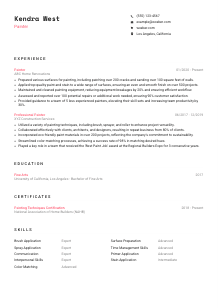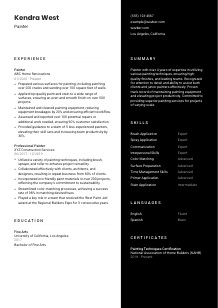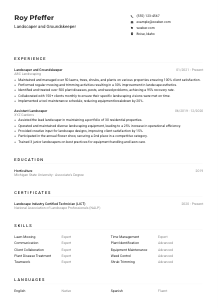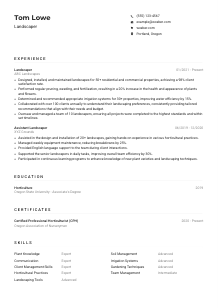Painter Resume Example
Brushing life onto canvases, but your resume feels like a blank page? Dive into this Painter resume example, mixed and composed using Wozber free resume builder. Learn how to artistically blend your palette of skills with job criteria, crafting a career narrative as vibrant as your finest masterpieces!
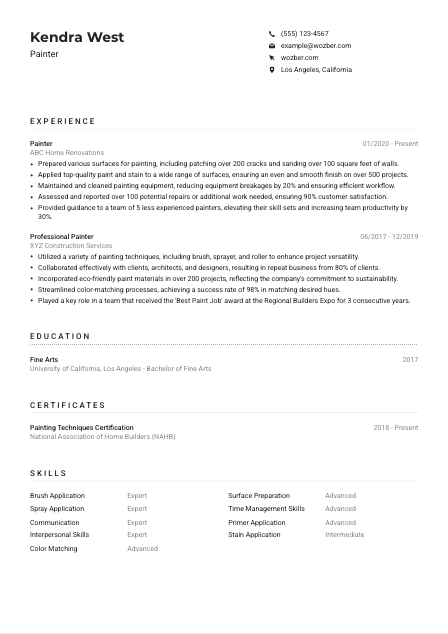
How to write a Painter Resume?
Hello, aspiring Painter! In the vivid world of professional painting, your resume is like your most important canvas. It's not enough to splash your skills and experiences haphazardly across the page. You need to be as thoughtful and precise as when mixing the perfect shade of color.
Crafted with care, this guide, powered by Wozber's free resume builder, will paint a clear path for you. You'll learn how to make your resume not just ATS-compliant but a compelling portrait of your professional prowess. Let's dip our brushes and start!
Personal Details
Let's face it, the personal details section is your resume's frame – it sets the tone. Here, every stroke counts, from the choice of font to the inclusion of essential contact details. Aim for elegance and clarity, ensuring that this snapshot of your background immediately captivates the hiring manager's attention.
1. Name with Flair
Your name is the bold signature on your work of art. Make it stand out with a readable font, slightly larger than the rest to draw immediate attention. It's the stamp of your personal brand.
2. Job Title as Your Muse
Directly beneath your name, the job title acts as your painting genre, drawing immediate attention to the specific role you're mastering. In this instance, adding "Painter" grounds your resume, making it resonate with the job at hand.
3. Contact Info: Clear as a Polished Canvas
Provide your phone number and a professional email, akin to laying the initial layers of a master painting. A sloppy email address is like an unpainted edge—overlooked until it spoils the overall image.
4. Locale: Set Your Scene
The job's in Los Angeles, California, so your address or mentioning your location assures there's no mismatch. It's about grounding your piece in its setting, showing you're accessible and ready.
5. Online Portfolio: Show, Don't Tell
If you have a professional website or LinkedIn profile showcasing your work, include it. Like a gallery exhibition of your best work, it offers a richer, more dynamic view of your talents.
Takeaway
This initial brushstroke is crucial. It sets the stage for your narrative, inviting the viewer to step closer and explore the layers of your experience and skills. With every detail, you're building anticipation, ensuring that each piece of information adds to the allure, making the hiring manager eager to delve deeper.





Experience
In the dazzling gallery of your career, each position you've held is a painting showcasing your growth and mastery. But how do you ensure that each piece in your collection sings in harmony with the job you're after? Let's explore how.
- Prepared various surfaces for painting, including patching over 200 cracks and sanding over 100 square feet of walls.
- Applied top‑quality paint and stain to a wide range of surfaces, ensuring an even and smooth finish on over 500 projects.
- Maintained and cleaned painting equipment, reducing equipment breakages by 20% and ensuring efficient workflow.
- Assessed and reported over 100 potential repairs or additional work needed, ensuring 90% customer satisfaction.
- Provided guidance to a team of 5 less experienced painters, elevating their skill sets and increasing team productivity by 30%.
- Utilized a variety of painting techniques, including brush, sprayer, and roller to enhance project versatility.
- Collaborated effectively with clients, architects, and designers, resulting in repeat business from 80% of clients.
- Incorporated eco‑friendly paint materials in over 200 projects, reflecting the company's commitment to sustainability.
- Streamlined color‑matching processes, achieving a success rate of 98% in matching desired hues.
- Played a key role in a team that received the 'Best Paint Job' award at the Regional Builders Expo for 3 consecutive years.
1. Analyze the Composition
Begin by dissecting the job description, identifying the shades and techniques that will make your resume resonate. Highlight the details: "Professional painting experience," "variety of painting techniques," and "team guidance," among others.
2. Choose Your Exhibits Wisely
Order your work chronologically, starting with your most recent role. Ensure each position listed underscores your prowess in the required areas, setting the scene with job titles, companies, and dates.
3. Palette of Achievements
Use bullet points to illustrate your accomplishments, ensuring they're as vivid and engaging as your work. Whenever possible, quantify your achievements—like the number of projects completed or the percentage improvement in customer satisfaction.
4. Strokes of Specificity
When detailing your experience, keep your strokes specific and relevant. Did you specialize in mural painting, or perhaps in detailed frescoes? Highlighting these specifics makes your resume a gallery of your unique talents.
5. Collaboration as a Color
Emphasize teamwork and collaboration skills, vital pigments in the palette of every Painter position. Mention projects where your guidance or teamwork led to exquisite results, mirroring the job description's demand for collaborative skills.
Takeaway
Think of the experience section as an exclusive showing of your career journey. Each role you list is an exhibit, a testament to your craftsmanship, dedication, and evolution as a professional painter. Make it count by aligning each entry with the job requirements. Let the hiring manager stroll through your career gallery, marveling at the depth and breadth of your skills and achievements.
Education
Just like preparing a canvas, your educational background sets the groundwork for your professional qualifications. Even if the role doesn't demand a degree in fine arts, the right educational details can add depth and context to your resume.
1. Sketching the Basic Structure
Though the job might not specify educational prerequisites, listing your degree, field of study, and the institution provides a solid foundation, showing you're not just skilled but also well-rounded.
2. Keeping it Balanced
Maintain simplicity and clarity. Your education is an essential layer, but it shouldn't overpower the rest of your resume. List only those details that add to the narrative of you as the ideal Painter candidate.
3. Color with Achievements
Did your education journey include notable achievements or specific courses relevant to your painting career? Highlight these, but be selective—only include what truly enhances your profile for this particular role.
4. Shadowing with Extracurriculars
Extracurricular activities, especially those related to your craft, can add depth, revealing aspects of your passion and commitment not immediately apparent from your job roles alone.
5. Match the Hue
Match your educational details to what the role implicitly requires. A degree in Fine Arts, as in our resume example, subtly underscores a foundational understanding of aesthetics and technique, reinforcing your expertise.
Takeaway
Your educational background, though a quieter line in the overall composition of your resume, still plays a critical role. It supports every other aspect, grounding your professional achievements in a solid base of knowledge and structured learning. Portray it with just enough detail to impress, but not so much that it overshadows your experiences and skills.
Certificates
In the world of painting, as in many crafts, continuous learning and certification showcase your commitment to excellence and mastery of specific skills. Let's see how to weave these into your resume in a way that illustrates your dedication and proficiency.
1. Selecting Your Best Works
When it comes to certifications, quality trumps quantity. Include those that are most relevant to the role and the most prestigious. A "Painting Techniques Certification" directly speaks to your technical skill set.
2. Framing with Dates
Include the dates for each certification to provide context. Recent or current certifications, like the Painting Techniques Certification (2018 - Present), show your ongoing commitment to staying at the forefront of your craft.
3. Composition with Relevance
Each certification should add a stroke of skill or knowledge that enhances your suitability for the Painter role. If it directly mirrors a requirement in the job description, it's a must-include.
4. The Palette of Lifelong Learning
Indicate your willingness to continually enhance your skills. Ongoing education and certification not only underline your technical abilities but also demonstrate a mindset geared towards growth and improvement.
Takeaway
Your certifications are like the varnish on your portfolio, adding a finishing touch that elevates the overall impression. They validate your skillset and ongoing dedication to your craft. Select and present them thoughtfully, ensuring that each one contributes meaningfully to the picture you're painting of your professional self.
Skills
The skills section of your resume is where you get to display your professional palette. The key is not just to list skills but to blend them in a way that showcases how perfectly you fit the Painter role you're targeting.
1. Select Your Colors
Start by deciphering which skills are most sought after for the position. From the job description, extract those you possess: brush and spray applications, color matching, and strong attention to detail.
2. Masterful Blending
Like mixing paint, combine hard skills with soft ones. Balance your technical proficiency in painting techniques with your effectiveness in communication and teamwork, just as the job description requires.
3. Strokes of Clarity
Keep this section organized and focused. While it might be tempting to list all your skills, aim for those that directly contribute to the picture of you as a perfect fit for this Painter position.
Takeaway
Your skills section is the vivid splash of color that draws the viewer's eye. It shows at a glance your capabilities and how they align with the job's needs. Paint this section with strokes of precision and care, ensuring that it accurately reflects the depth of your professional palette.
Languages
Language skills can add an interesting dimension to your resume, much like the right accent color can animate a painting. In a city like Los Angeles, the ability to communicate in multiple languages can be a distinctive advantage.
1. Primary Color: English Proficiency
Since the job requires "good English proficiency", this should be the base color of your linguistic profile. Clearly list your fluency level to align perfectly with the job's requirement.
2. Additional Hues
Any additional languages you speak add richness and depth to your profile, showing versatility. If you know Spanish, even at a basic level, list it—it could be just the nuance the employer is looking for.
3. Evoking Authenticity
Be candid about your language abilities. Overstating your fluency can lead to misunderstandings, much like choosing the wrong shade can disrupt the harmony of a painting.
4. Complementary Tones
While the job might not explicitly demand other languages, your ability to communicate even on a basic level in another language reflects adaptability and a global mindset.
5. Brushing Up
Consider this section as an invitation to improve. Language skills, like painting techniques, can always be honed and perfected. It's an area where lifelong learning can open new doors and opportunities.
Takeaway
Languages on your resume add a layer of cultural and communicative proficiency that can greatly enhance your appeal, especially in diverse and multi-ethnic settings like Los Angeles. Treat them as you would any special technique in your artistic arsenal—valuable, distinctive, and worth developing.
Summary
Just as an artist's statement gives insight into their vision, your resume summary offers a glimpse into your professional identity. It's a concentrated burst of information, setting the tone for everything that follows.
1. Setting the Scene
Begin with an overview, much like an artist contemplating a blank canvas. Reflect on your professional journey and the essence of what makes you a standout Painter.
2. Key Highlights
Use this space to underscore your top skills and most impactful achievements. In essence, it's a high-level overview of your career's most vivid and memorable moments.
3. In Essence
Think of your summary as the concentrated pigment of your professional story. It should capture the essence of your skillset and experiences, clearly and concisely, within 3-5 lines.
4. A Touch of Personality
Let your individuality shine through. While keeping it professional, infusing a bit of your personal approach to painting can make your summary more engaging and memorable.
Takeaway
Your summary is the opening act, the tease that invites further exploration. Craft it with the awareness that this might be the first—and possibly the only—section a busy hiring manager reads. Make it a reflection of your professional self, compelling and rich with promise.
Brushes Down: Your Painter Resume Masterpiece
With each section tailored and polished, your resume is now a testament to your skills, experiences, and the unique flair you bring to the Painter role. By following this guide, you've crafted a document that not only meets the ATS optimization criteria but also resonates on a human level, reflecting your passion and dedication to your craft. Remember, Wozber's free resume builder, ATS-friendly resume templates, and ATS resume scanner are here to help you refine and perfect your resume, ensuring it's ready for any gallery—be it a job portal or the desk of a hiring manager. Your next career masterpiece is just a submission away.
The world is waiting for your brushstrokes. Go forth and paint it with your talent!

- Minimum of 2 years of professional painting experience.
- Proficiency in a variety of painting techniques, including both brush and spray applications.
- Strong attention to detail and the ability to match colors precisely.
- Effective time management skills to ensure projects are completed within set deadlines.
- Excellent communication and interpersonal skills to work collaboratively with clients and team members.
- Must have good English proficiency.
- Must be located in Los Angeles, California.
- Prepare surfaces for painting including patching cracks, sanding, and applying primer.
- Apply paint or stain to a variety of surfaces, ensuring an even and smooth finish.
- Maintain and clean painting equipment regularly.
- Assess and report any necessary repairs or additional work needed to ensure customer satisfaction.
- Provide assistance and guidance to less experienced painters on the team if required.





